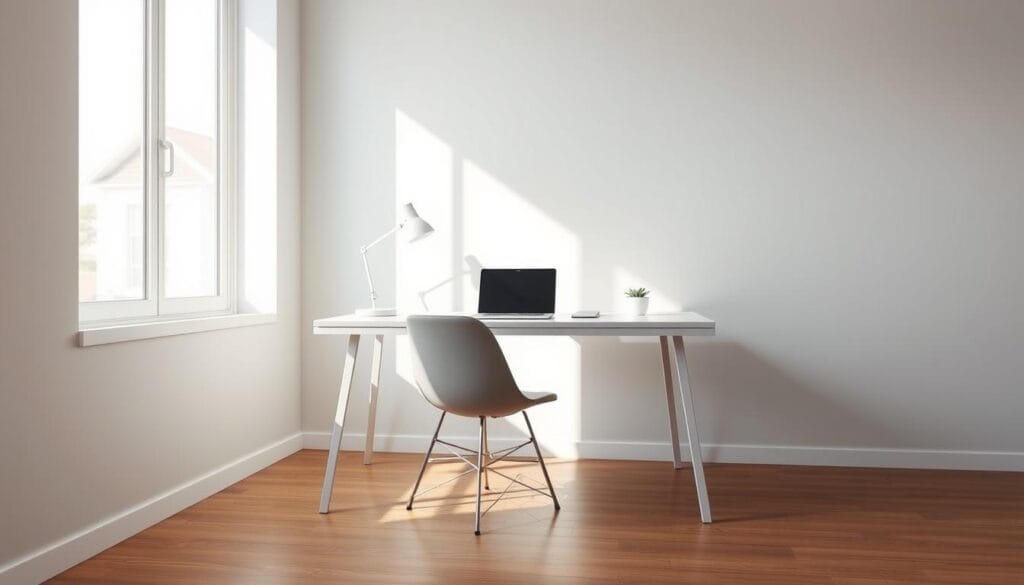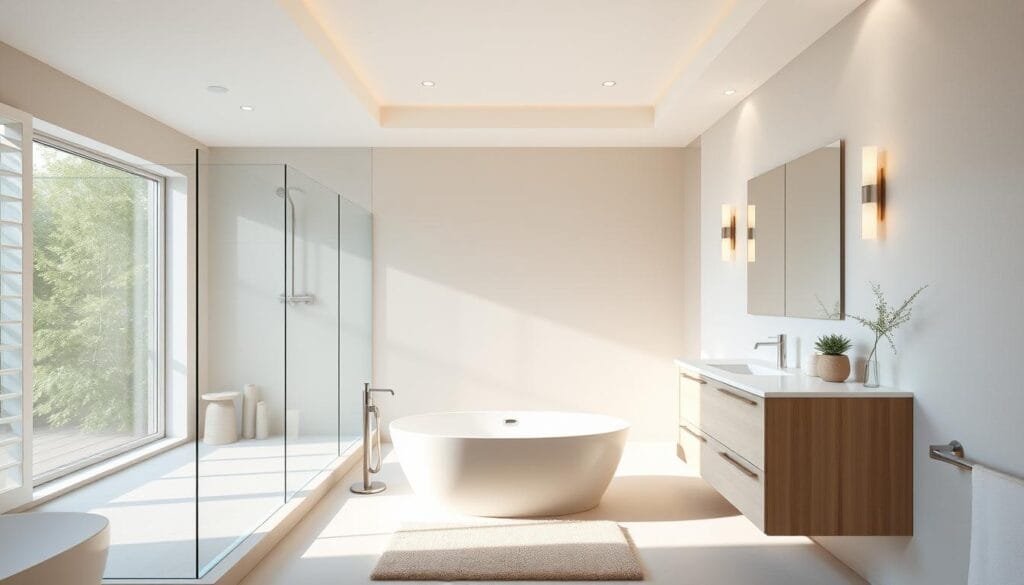Imagine entering a home where everything serves a purpose and tranquility surrounds you. This is the essence of Japanese minimalist interior design. Envision a clean space, bright with natural light and simple, yet beautiful furniture made from organic materials. Such spaces promote a calm and balanced way of living.
Last summer, I visited a friend’s home in Los Angeles that perfectly captured Japanese minimalist interior design. From the moment you entered, the scent of natural wood and indoor plants welcomed you. The space was open and welcoming, with sliding shoji screens that cleverly divided the rooms.
Every piece of furniture complemented one another beautifully. The low-profile furniture and soft, neutral colors created a serene space. This design approach goes beyond looks; it fosters a feeling of being both grounded and uplifted.
Japanese minimalist design focuses on simplicity, purity, and smart storage to maintain clean, functional spaces. This style turns living areas into peaceful retreats that encourage mindful living. If you’re interested, you can learn more about this decorating style here.
This design style is founded on principles that cherish harmony, calmness, and the beauty of imperfection, or Wabi-Sabi. Designers like Tadao Ando and Shigeru Ban have shown that minimalism can deeply express life. By blending nature, craftsmanship, and the concept of ‘kanso’ (removing clutter), they create spaces that uplift both functionally and spiritually.
Want to see how this looks? Take a look at this image showing the beautiful simplicity of Japanese design:
Understanding Japanese Minimalist Interior Design
Modern Japanese interiors bring to mind peaceful areas, clean shapes, and perfect balance with nature. This style is not just nice to look at. It is also full of deep cultural meanings and ideas.
The Philosophy Behind Minimalism
Japanese minimalist design draws heavily from the country’s love for nature and cultural beliefs. It’s all about having less to make a space feel calm and organized. This contrasts sharply with the hectic urban lives most of us lead.
Minimalism took off as a key design trend after World War II, especially from the 1960s to the 1970s. By the 1980s, minimalist design, known for its simple lines and neutral colors, had spread far and wide.
Key Principles of Japanese Design
Looking into Japanese design’s core, we find important concepts and strategies. The minimalist way in Japan pushes for living with only what you need. Here are the main parts that make up a modern Japanese interior:
- Simple Lines: Pieces of furniture and buildings with straightforward, plain lines.
- Neutral Color Palettes: Mainly one-color themes or brown shades that make natural light better.
- Limited Furniture: Only keeping pieces that are needed for use and comfort.
- Creative Storage Solutions: Hidden storage that keeps the area looking tidy.
- Open Floor Plans: Spaces without barriers to make them feel bigger and more open.
- Natural Light: Making the most of natural light to create a bright and peaceful atmosphere.
Minimalism also supports being more eco-friendly, which is crucial because of the climate crisis. By using materials like wood, stone, and glass, Japanese design links us to nature. This makes every space feel well thought out and meaningful, instead of empty.
Choosing Japanese minimalist design means more than making a place look good. It means making a space that brings peace, focus, and purposeful living. By using natural elements and smart designs, we can make homes that are simple. They also honor our cultural past and are good for our planet.
The Importance of Natural Elements
In Japanese minimalist design, it’s key to blend natural elements into living spaces. This approach follows traditional Japanese architecture. It also gives a room a feel of calm and balance. We’ll see how wood and nature, plus thoughtful lighting, can change a home.
Incorporating Wood and Nature
Wood is a main part of traditional Japanese architecture. It’s seen in floors, walls, and furniture. The beauty of natural wood grain adds to the simple grace of minimalist rooms. Adding plants like bamboo, bonsai trees, and orchids brings nature’s beauty inside. These natural touches are not just for looks; they make a space calm and eco-friendly.
Japanese homes often have gardens that link the inside and outside. Features like big windows and indoor gardens highlight this connection. These design choices keep nature close in everyday life. Water features in gardens bring natural sounds, promoting a sense of peace and purity. This focus on water is key in zen design.
The Role of Light in Japanese Interiors
Natural light is vital in zen design. Japanese homes are designed to capture views of mountains, water, or gardens. Doors like shoji doors are made to let in light and blend indoor and outdoor spaces.
Shoji doors and open spaces increase natural light by about 40%. This also makes a place calm and welcoming. The use of shadows and light adds depth. The traditional colors of Japanese homes add to a peaceful feel.
Using natural materials looks good and is better for the planet. Bamboo is chosen for its fast growth, and reclaimed wood helps save trees. A focus on less clutter can make small rooms feel 30% bigger. Studies say natural elements and materials can make people feel 20% happier and more relaxed.
| Natural Elements | Benefits in Design |
|---|---|
| Wood | Enhances elegance, sustainable |
| Bamboo | Rapidly renewable, durable |
| Water Features | Adds natural sound, reflects peace |
| Plants (Bonsai, Orchids) | Improves air quality, reduces stress |
| Shoji Doors | Allows natural light, connects outdoors |
Color Schemes in Japanese Interior Design
Japanese interior design begins with calming, neutral colors. These colors make every space feel simple yet elegant. They carry the calmness and tranquility important in Japanese style.
Neutral Palettes for Serenity
White, beige, and grey are key for a calm and open space. These colors reflect nature found in Japan, making rooms peaceful and flexible. They are perfect for DIY lovers to make rooms look bigger and clean.
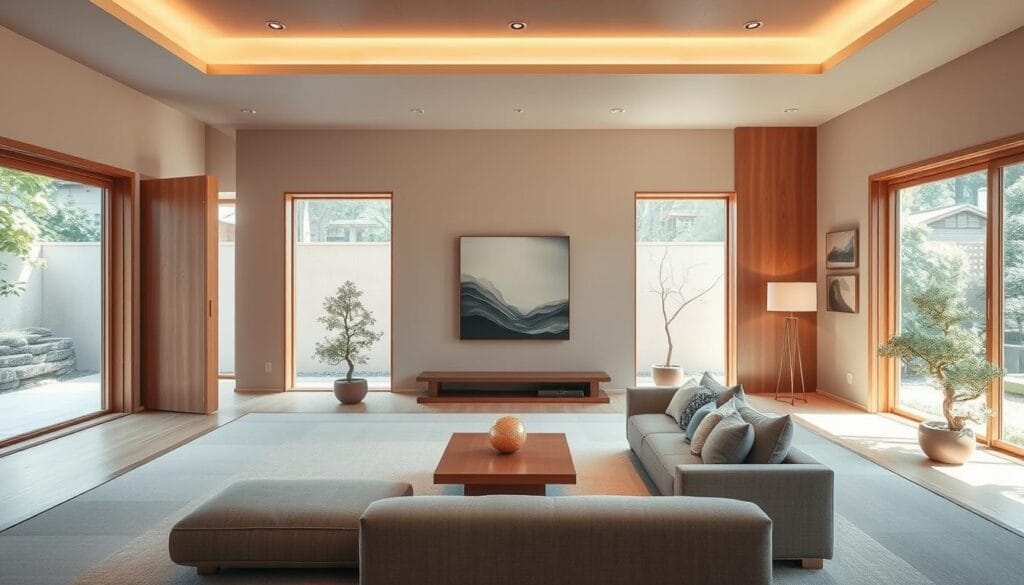
Accent Colors and Their Impact
Accent colors add depth to rooms with basic neutral colors. Colors like green and brown bring in the beauty of nature. A touch of red or indigo creates a stunning look while keeping harmony.
Using these natural shades smartly can make a simple space lively yet peaceful. Just one or two bold accents are enough. They keep the room focused and calming.
Space Optimization Techniques
Optimizing space is key to the serenity and usefulness of a modern Japanese home. By using open floor plans, we make rooms flow together smoothly. This makes our homes look simple and work better, especially in small city houses.
Open Floor Plans
Open floor plans are a big part of modern Japanese interior design. They take out walls and doors we don’t need, making one big space. This makes moving and talking easier, and our homes feel 30% bigger in tight spots.
Using sliding shoji doors adds flexibility and lets in natural light, cutting down on electric lights by about 25%.
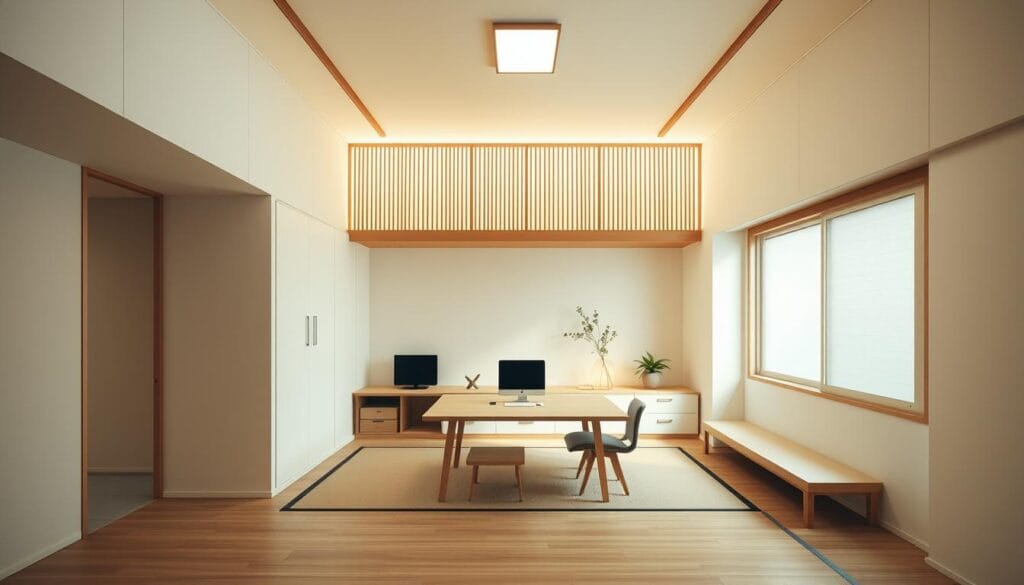
Multi-Functional Furniture
Using furniture that does more than one thing helps keep our homes tidy and ready for anything. A table that’s both for meals and work can up our social time by 15%. Tatami mats, which are comfy to relax on, increase coziness by 20%.
These choices not only improve relaxation. They also keep the calm and balanced feel of a modern Japanese home.
Furniture Selection in Japanese Minimalism
Choosing the right furniture is key in Japanese interior design, which loves simplicity and function. It’s all about harmony with nature. So, picking each item is very important.
Essential Pieces for an Authentic Look
For a true Japanese minimalist look, you need specific furniture. Think low-platform beds, modular storage, and simple decor. These pieces keep things functional and simple, yet beautiful. For example, a futon-like bed offers comfort and fits the minimalist vibe. Tatami mats bring texture and a natural touch to the room.
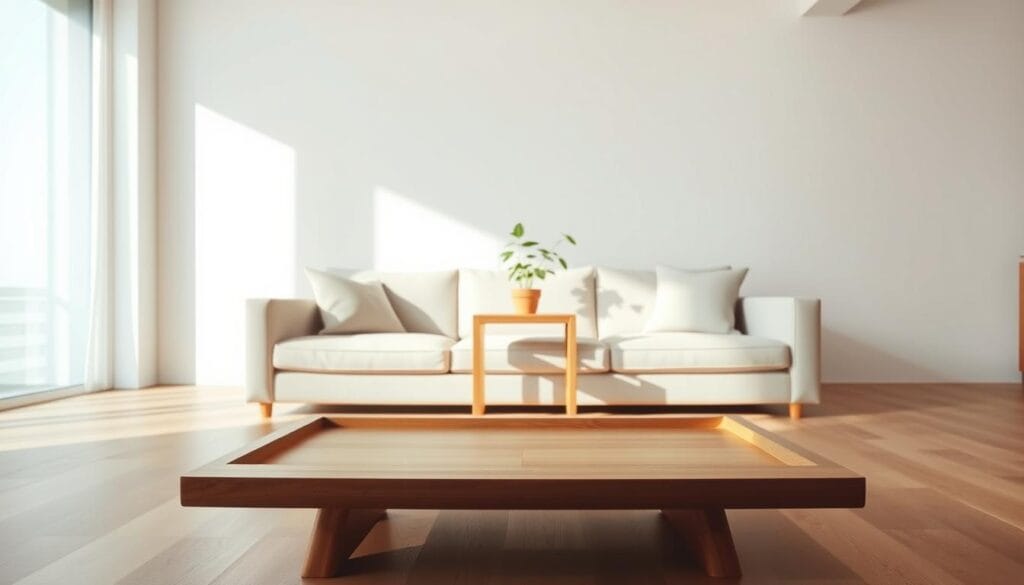
Tips for Choosing Minimalist Furniture
When picking furniture for a Japanese minimalist space, go for natural stuff like wood and stone. These bring in beauty and a zen feel. Choose items with simple lines and neutral colors like beige and white. This helps create a calm, tidy space. Also, look for multipurpose pieces; a coffee table that also holds items is a good choice. By choosing intentionally, you make your home peaceful and neat.
Textures and Materials
When discussing minimalist home decor with a Japanese twist, textures and materials are very important. Japanese design loves using natural elements. These add warmth and texture but keep the space simple. Using natural fabrics and stone makes your interior calm and inviting.
Natural Fabrics and Textiles
Natural fabrics are key in minimalist home decor that’s inspired by Japanese style. Think of cotton, linen, and wool in soft, neutral colors. They match wooden accents well. These materials are chosen for how they look and feel. They make your home feel peaceful and cozy.
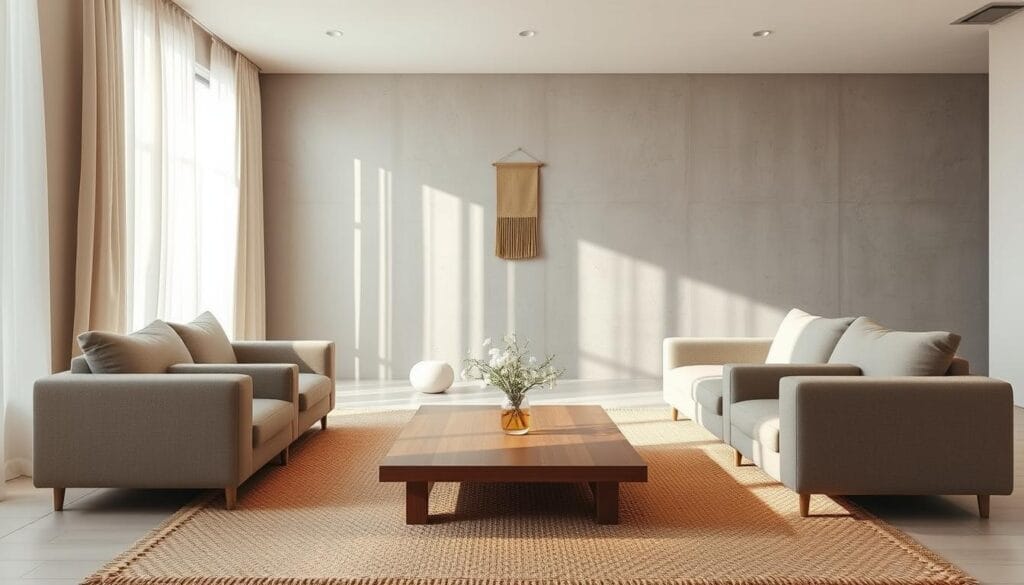
| Fabric | Properties | Durability |
|---|---|---|
| Cotton | Soft, Breathable | High |
| Linen | Lightweight, Cool | Medium |
| Wool | Warm, Resilient | High |
The Use of Stone and Other Organic Materials
Stone is a key material in Japanese minimalist design. It’s very durable and easy to take care of. Stone is great for floors, counters, and decorations. Its natural look brings a bit of the outdoors inside. This fits perfectly with the minimalist vibe. Bamboo is also a great choice for flooring and walls. It grows quickly and is very eco-friendly.
| Material | Characteristics | Durability |
|---|---|---|
| Stone | Hard, Prestigious | Very High |
| Bamboo | Sustainable, Fast-Growing | High |
| Hinoki Wood | Renewable (if sourced properly) | High |
Decorative Elements and Artwork
In modern Japanese decor, choosing the right decorative items and artwork is key. Each piece adds to the area’s calm and balance. Everything fits perfectly, showing the “less is more” philosophy.
Minimal Artwork Choices
Choosing art for a Japanese-style room means picking simple yet meaningful pieces. You might see walls with minimalist paintings of Japanese scenes or abstract art that makes you think and feel calm. The art adds depth but keeps things simple.
Adding a few cherry blossoms or hanging scrolls can draw attention without filling the space too much. Having little artwork keeps the room looking peaceful and clean.
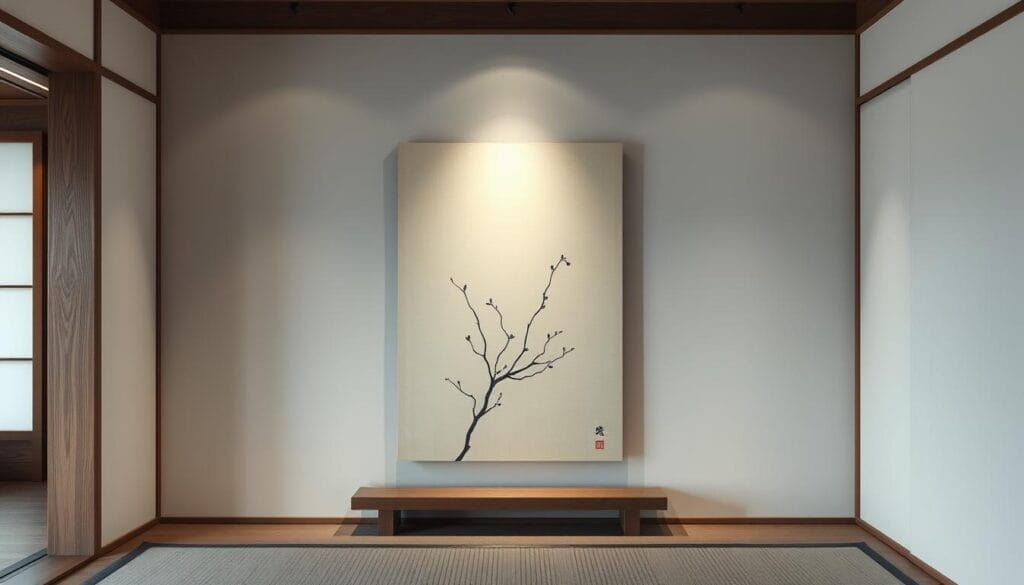
Integrating Cultural Symbols
Using cultural symbols adds personality to a minimal space. You can use ikebana or shou sugi ban to mix traditional and modern styles. The design uses negative space thoughtfully so that each piece stands out without crowding the room.
When making a room with a Japanese feel, it’s important to carefully choose and place each item. For more on minimalist Japanese design, check out this comprehensive guide.
The Influence of Zen Buddhism
Zen Buddhism significantly shapes minimalist interior design, adding peace and mindfulness. This approach values simplicity, balance, and connecting deeply with nature. These ideas from Zen help create spaces for peace and self-reflection.
Creating Calm and Tranquility
The idea of yohaku-no-bi, or the beauty of empty space, is key in Zen design. It helps us avoid clutter and lets a room feel more open and balanced. Zen gardens from the 15th century show how nature can make a place peaceful. A single bonsai tree can greatly improve a room’s feel, making it more calm, says Joseph Yuen.
Mindfulness in Interior Spaces
Wabi-sabi, finding beauty in imperfection, is a big part of mindful design. It lets us appreciate how natural materials change beautifully over time. Using bamboo, stone, and wood in our homes adds real charm.
Tadao Ando and his designs show how empty and full spaces work together. His work, along with Ludwig Mies van der Rohe’s “less is more” belief, shows the lasting importance of Zen in design.
Natural light plays a key role in making spaces welcoming. Large windows and smaller light sources like lanterns add to a room’s warmth. Influenced by the Muromachi era, these designs make our homes more peaceful and reflective. They help bring mindfulness and tranquility into our lives.
Lighting and Its Importance
Lighting is key in Japanese minimalist interiors. It shapes the mood and how we use the space. Natural and man-made light are both vital for simplicity and peace. Let’s explore what makes lighting work so well in minimalist Japanese designs.
Natural vs. Artificial Light
Natural light is a must in Japanese minimalist designs. Big windows and sliding doors let in lots of sunlight. This links the inside to the outdoors, making rooms feel bigger and more peaceful.
When there’s not enough natural light, choosing the right artificial light matters. Simple, clean lighting fixtures are preferred, with no extra decor. LED bulbs are good choices for their long life and lower costs. Warm light colors make spaces cozy. Dimmable lights let you change the light for different times and feelings.
Choosing Fixtures that Complement Design
Picking out lighting fixtures that go with minimalist decor is important. For example, Japandi style uses natural things like wood, paper, and bamboo for a warm feel. Lights like the Saranella large portable table lamp and the Erna bamboo ceiling lampshade work well with this look. They blend in but still give off good light.
Having different kinds of lighting is key. Mix general, specific, and accent lights to make the room look its best. Soft light options, like the rice paper lamp and the Sahar Mango Wood Floor Lamp, soften sharp shadows. These choices reflect the calm and timeless nature of Japandi and Japanese minimalism, making homes that feel right no matter what the current trend is.
Maintenance of Minimalist Spaces
Maintaining a Japanese minimalist space means you must clean regularly and declutter carefully. This keeps the design simple and clear. To keep such a peaceful place, you need special methods. And you must stick to minimalist cleaning habits all the time.
Cleaning and Upkeep Tips
To clean well, try using minimalist approaches which involve planned schedules and natural cleaners. For instance, tidying up for just five minutes each day can make a big difference. It cuts down on the time you spend cleaning overall.
Also, it’s smart to invest in good storage like Japanese Tansu chests or ottomans with hidden spots. These keep your surfaces clean and hold onto the minimalist look.
The Importance of Decluttering
Decluttering is key in minimalist areas to stop unnecessary items from piling up. Use our advice by taking a bit of time each week to look over your stuff. Hold onto things that are useful or make you happy. Picking decor that focuses on quality instead of quantity means you’ll have less to clean. This makes it easier to keep your place neat. Plus, remember, a tidy, decluttered area is essential in Japanese minimalist style. It helps create a calm, stress-free setting.
How to Get Started with Your Home
Starting your journey into Japanese minimalist interior design means learning about its deep philosophy. It’s more than just a way to design; it’s a lifestyle that values simplicity and peace. To start, focus on decluttering your space. This is key because a clean space helps reduce stress.
Steps to Transform Your Space
Begin by tackling one room at a time. This approach helps you manage decluttering better. Keep only necessary furniture and clear everything else from the floors. Minimalist homes usually have calm color schemes like white or soft earth tones. These colors make spaces feel peaceful and look bigger.
Use furniture that serves more than one purpose. For example, choose tables that fold out or beds that convert into sofas. Bring in natural materials like wood and straw. Adding indoor plants, like Bonsai, invites calmness inside.
Resources for Further Inspiration
Looking for more minimalist design ideas? Check out design books on Japanese style. Online guides and visual inspirations are available on websites. Joining community forums can be very helpful because you can get tips from others who love minimalism. You can also talk to interior design experts for advice tailored to you. With these resources, creating a minimalist space is both exciting and doable.


